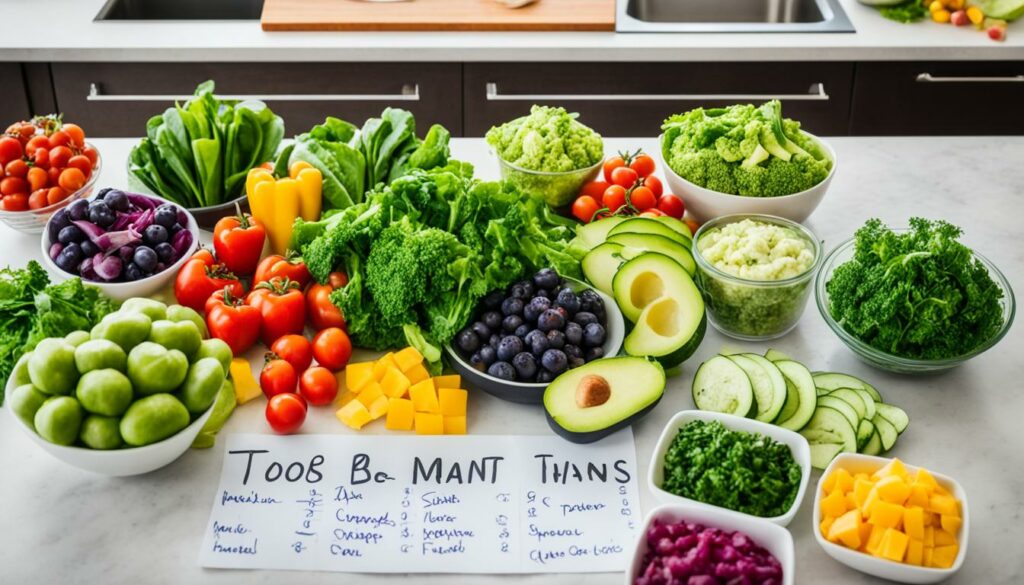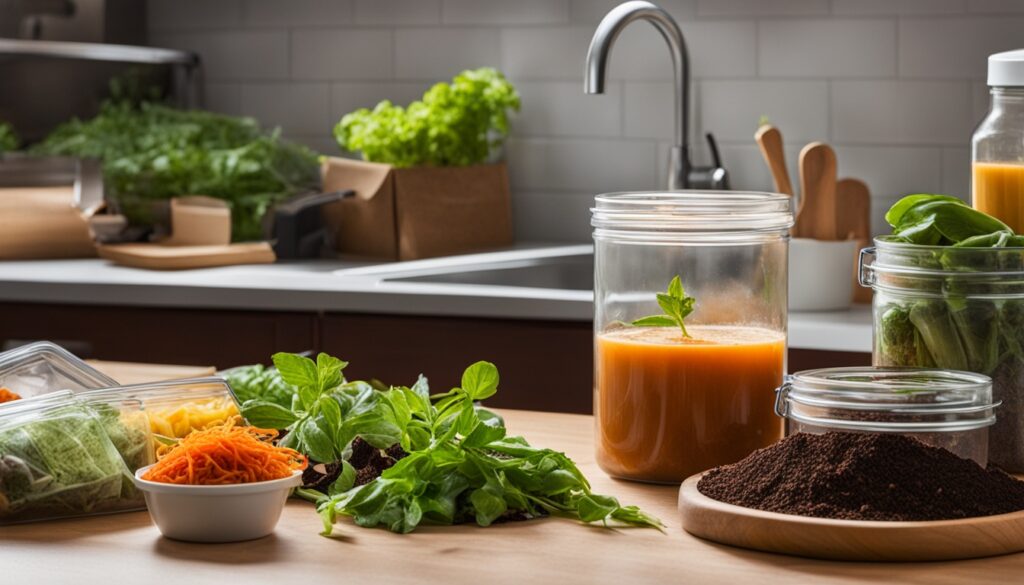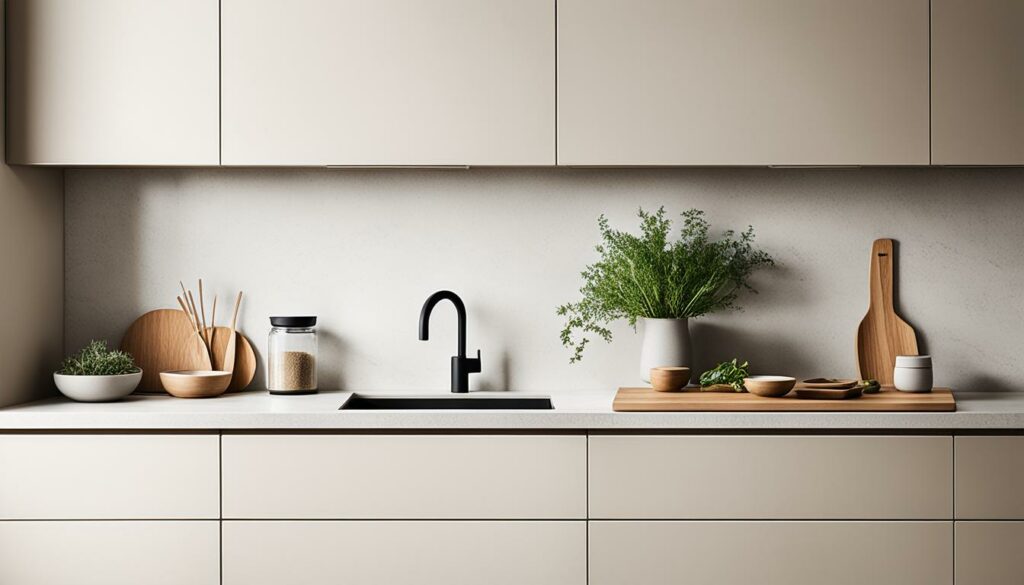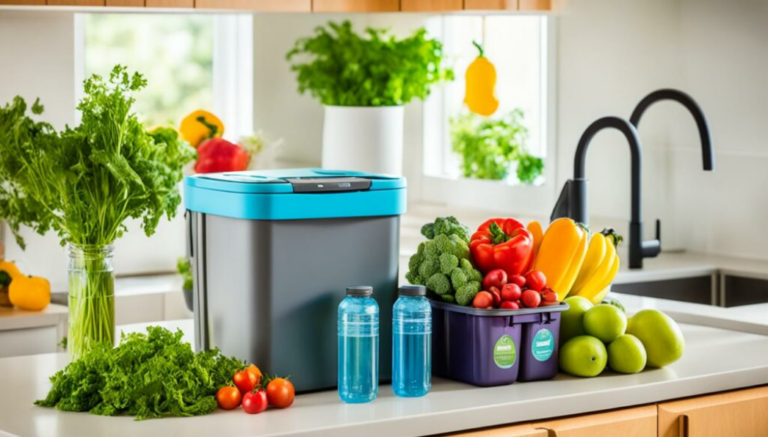I love cooking at home, but I’ve noticed how much waste it creates. The single-use plastics, food scraps, and energy-using appliances bothered me. I wanted to change that.
So, I decided to make my kitchen zero waste. It was hard, but it’s changed everything. Now, I’ve cut down on waste and found new joy in cooking. I want to share how I did it and encourage you to try too.
Key Takeaways
- Embrace a zero-waste mindset to reduce your environmental impact in the kitchen.
- Declutter and organize your kitchen for efficient and sustainable cooking
- Build a plastic-free pantry and choose sustainable storage solutions
- Implement strategies to reduce food waste, including meal planning and creative use of leftovers
- Discover essential zero-waste tools and gadgets to support your eco-friendly kitchen
Embracing a Zero Waste Mindset in the Kitchen
Before we dive into how to make a zero waste kitchen, let’s talk about why it’s important. Food waste has a huge impact on our planet. By adopting a zero waste mindset, we can cut down on waste and gain many benefits that go beyond the kitchen.
Understanding the Impact of Food Waste
Food waste is a big problem worldwide. The United Nations says about one-third of all food produced for us is thrown away. That’s a huge 1.3 billion tons of food wasted every year. This waste harms the environment a lot, causing greenhouse gases, using up resources, and harming ecosystems.
Benefits of a Zero Waste Kitchen
Having a zero waste kitchen brings many benefits, including:
- Cost savings from less food waste and better use of resources
- Less harm to the environment by cutting down on waste and emissions
- Better food security by using all available resources well
- A more eco-friendly lifestyle that matches our values
Knowing how food waste affects us and the good things about a zero waste kitchen, we can make big changes. These changes help us work towards a greener future.
Decluttering and Organizing Your Kitchen
A clean and organized kitchen is key to a successful zero waste life. By getting rid of clutter and using space wisely, we can think more about what we buy. This helps us use our kitchen better.
Start by getting rid of things you don’t need. Look at your cabinets, drawers, and countertops. Ask yourself, “Do I really need this? When was the last time I used it?” Give away, recycle, or throw away anything you haven’t used in a year.
- Assess your kitchen tools and appliances.
- Declutter spice racks, pantry items, and cooking utensils.
- Organize cabinets and drawers for maximum efficiency.
Then, find creative ways to store things in your kitchen. Use shelves that adjust, drawer organizers, and hanging racks. This helps keep your kitchen looking good and things easy to find.
| Storage Solution | Benefits |
|---|---|
| Adjustable Shelves | Maximize vertical space, customize to fit your needs |
| Drawer Organizers | Keep utensils, spices, and small items neatly in place |
| Hanging Racks | Free up counter and cabinet space, display frequently used items |
Decluttering and organizing your kitchen helps you live a zero waste life. It makes cooking easier and can make you think more about your choices. A clean kitchen can also make you more mindful and help you use what you have wisely.
Building a Plastic-Free Pantry
Creating a plastic-free pantry is key to a zero waste kitchen. By ditching single-use plastics and choosing sustainable storage, we can lessen our environmental impact. Let’s look at how to build a plastic-free pantry and the perks of sustainable storage and alternatives to single-use plastics.
Choosing Sustainable Storage Solutions
Traditional plastic containers can be swapped out for more eco-friendly ones in your pantry. Think about getting glass jars, stainless steel canisters, or airtight ceramic containers for your dry goods, grains, and spices. These options are not only good-looking but also keep your food fresh and cut down on plastic waste.
| Sustainable Storage Options | Benefits |
|---|---|
| Glass Jars | Reusable, durable, and easy to clean |
| Stainless Steel Canisters | Rust-resistant, airtight, and long-lasting |
| Ceramic Containers | Stylish, non-toxic, and excellent for dry goods |
Avoiding Single-Use Plastics
It’s also key to get rid of single-use plastics from your pantry. Swap plastic wrap, baggies, and disposable containers for reusable ones like beeswax wraps, silicone bags, and glass or stainless steel containers. These single-use plastic alternatives cut down on waste and help make your kitchen more eco-friendly.
By making your pantry plastic-free and using sustainable storage, you’re taking a big step towards a zero waste kitchen. Remember, even small changes can make a big difference for the environment. So, start making your pantry more eco-friendly today.
Reducing Food Waste
Food waste is a big problem, with tons of edible food thrown away every year. We can cut down on food waste by using smart strategies in our kitchens. This section will cover meal planning, shopping tips, and creative ways to use leftovers. This way, we make sure no food goes to waste.
Meal Planning and Shopping Strategies
Planning meals is key to reducing food waste. By planning meals and making a shopping list, we buy only what we need. This helps avoid buying things we might not use. Also, using leftovers in our meals helps us use every ingredient.
- Create a weekly meal plan based on your family’s preferences and dietary needs.
- Make a comprehensive grocery list before shopping to avoid purchasing unnecessary items.
- Check your refrigerator and pantry before heading to the store to avoid duplicates.
- Prioritize purchasing fresh, seasonal produce to ensure maximum freshness and flavour.
Creative Ways to Use Leftovers
Leftovers are a great way to fight food waste. With creativity, you can turn last night’s meal into something new. This saves time and cuts down on waste. You can use leftover proteins, veggies, or grains in many ways.
- Incorporate leftover proteins, vegetables, or grains into stir-fries, omelettes, or pasta dishes.
- Blend leftover fruits and vegetables into smoothies or soups.
- Repurpose cooked meats in sandwiches, tacos, or salads.
- Turn leftover rice or pasta into fritters, croquettes, or casseroles.
By using these meal planning and leftover reuse tips, we can greatly reduce food waste in our kitchens. This helps us all work towards a more sustainable future.

Zero Waste Kitchen: Essential Tools and Gadgets
Creating a zero waste kitchen means having the right tools and gadgets. You’ll need reusable storage containers and compost bins. These items make your zero waste journey easier and more fun. Let’s look at some key items that help reduce waste and make your kitchen work better.
Reusable Storage Containers
Goodbye to single-use plastic bags! Choose durable containers made from glass, stainless steel, or silicone. These can be washed and reused for leftovers, pantry items, and more. Zero waste kitchen tools like these cut down on plastic waste and keep your food fresh.
Compost Bin and Fermentation Crock
A quality compost bin is a big step for your eco-friendly kitchen gadgets. It lets you turn food scraps into nutrient-rich compost, keeping waste out of landfills. For fermentation fans, a fermentation crock is great for making tasty, gut-healthy foods like sauerkraut and kimchi.
Reusable Produce Bags
- Swap plastic produce bags for washable ones made from mesh or cotton.
- Zero waste kitchen tools like these help you carry and store fruits and veggies without waste.
- They often have tare weights for easy grocery store weighing.
Beeswax Wrap and Silicone Stretch Lids
Use reusable eco-friendly kitchen gadgets like beeswax wrap and silicone stretch lids instead of plastic wrap and foil. These can cover bowls, jars, and containers, keeping food fresh without disposable materials.
Adding these zero waste kitchen tools and eco-friendly kitchen gadgets to your routine helps make your kitchen more sustainable. These practical solutions support mindful, low-impact cooking and are good for the planet.
Sustainable Cooking and Meal Prep
In our quest for a zero waste kitchen, sustainable cooking and meal prep are key. Using eco-friendly cookware and utensils helps. Choosing low-impact ingredients also cuts down our environmental impact. This way, we enjoy tasty, healthy meals while helping the planet.
Eco-Friendly Cookware and Utensils
Choosing the right tools is important for sustainable cooking. Look for cookware made from materials like cast iron, ceramic, or stainless steel. These materials are durable and don’t need to be replaced often, which reduces waste. Use wooden or bamboo utensils instead of plastic ones. They are made from renewable resources and can break down easily.
Low-Impact Ingredients for Zero Waste Recipes
For zero waste recipes, pick your ingredients wisely. Choose produce that’s local and in season to cut down on carbon emissions. Go for whole foods with less packaging and fewer preservatives. When you can, pick organic and regeneratively grown foods to support farming that is good for the earth.
| Eco-Friendly Cookware | Low-Impact Ingredients |
|---|---|
| Cast iron skillets | Seasonal, local produce |
| Ceramic bakeware | Whole grains and legumes |
| Stainless steel pots and pans | Organic, sustainably sourced meats and dairy |
| Wooden and bamboo utensils | Plant-based milk and alternative proteins |
By focusing on sustainable cooking and choosing low-impact ingredients, we can make delicious, zero waste meals. These meals feed our bodies and help the planet.
Package-Free Grocery Shopping
Embracing package-free grocery shopping is a great way to cut down on waste in the kitchen. This approach not only reduces packaging waste but also helps local businesses and communities. By checking out bulk stores and farmers’ markets, you can get fresh, unpackaged ingredients. This supports sustainable food systems too.
Finding Local Bulk Stores and Farmers’ Markets
Looking for bulk stores and farmers’ markets in your area can change the game in reducing packaging waste. These places offer a lot of products, like grains, legumes, spices, and oils, all in your own reusable containers. By connecting with your local community, you can find places that fit your zero-waste lifestyle.
Tips for Bringing Your Own Containers
- Invest in a set of durable, reusable containers in various sizes to fit all your shopping needs.
- Label your containers with the product name and tare weight (the weight of the empty container) for accurate pricing at checkout.
- Learn the rules of package-free shopping at the bulk store or farmers’ market, and come prepared with your containers.
- Have a set of reusable bags ready for carrying larger items or produce.
| Benefits of Package-Free Grocery Shopping | Challenges to Consider |
|---|---|
| Less packaging waste Support for local businesses Access to fresh, unprocessed ingredients Can save money on some items | Finding reliable bulk stores or farmers’ markets Remembering to bring reusable containers Ensuring proper taring and pricing at checkout Adjusting to a new shopping routine |
By choosing package-free grocery shopping, you can greatly reduce waste and support sustainable food systems in your area. With some prep and a commitment to zero-waste, you can make your kitchen more eco-friendly.
Composting and Recycling in the Kitchen
Composting and recycling are key to a zero waste kitchen. They help us manage food scraps and non-compostable waste better. This reduces the environmental impact of our kitchen work. Let’s look at the benefits of composting and how to recycle better in the kitchen.
The Benefits of Kitchen Composting
Kitchen composting changes the game in reducing food waste. It turns organic waste into soil that’s full of nutrients. This helps our gardens and houseplants grow. It also cuts down on greenhouse gases and supports a healthier planet.
Setting Up a Composting System
Starting a kitchen composting system is easy. First, pick a small bin or container for food scraps on your countertop. Add things like fruit peels, eggshells, coffee grounds, and shredded paper. But leave out meat, dairy, and oily items as they can draw pests and mess up the compost.
Maximizing Recycling Efforts
Kitchen recycling is also vital for a zero waste life. Look for recyclable kitchen items like glass, plastic, metal, and paper. Create a recycling spot and make it easy for everyone to sort and store recyclables.
| Compostable Items | Recyclable Items |
|---|---|
| Fruit and vegetable scraps Eggshells Coffee grounds Shredded paper | Glass jars and bottles Plastic containers and bottles Aluminum cans Paper and cardboard |
By using kitchen composting and kitchen recycling, we can cut down on landfill waste. Every step towards a zero waste kitchen helps our planet.

Zero Waste Kitchen: Cleaning and Maintenance
Keeping your kitchen clean and working well is key to living zero waste. We’ll look at natural, eco-friendly cleaners to replace harsh chemicals. We’ll also give tips on using less water in the kitchen to lessen your environmental impact.
Natural and Eco-Friendly Cleaning Products
Traditional cleaners often have harmful chemicals that are bad for the planet and your health. Choose natural, plant-based cleaners that work well and are safe. Here are some eco-friendly options:
- Baking soda and vinegar for cleaning and getting rid of odours
- Castile soap for a gentle cleaner
- Essential oils, like lemon or tea tree, for cleaning and disinfecting
- Reusable cloths and sponges for cleaning without waste
Reducing Water Usage in the Kitchen
Using eco-friendly cleaners is just part of the story. You can also use less water in the kitchen. Here are ways to save water:
- Install faucets and appliances that use less water, like dishwashers and washing machines
- Don’t let water run while washing dishes, veggies, or your hands
- Use greywater (from sinks, showers, and washing machines) to water plants
- Watch how much water you use and try to save more in your daily routine
By choosing natural cleaners and saving water, you can keep your kitchen clean and eco-friendly. This supports your zero waste goals.
Minimalist Kitchen: Embracing Simplicity
Starting your zero waste journey? A minimalist kitchen can be a big help. It lets you cut down on clutter, work more efficiently, and be more mindful while cooking.
The kitchen simplicity movement is all about choosing what’s really important in your kitchen. It means keeping only the tools and ingredients that matter. This makes your kitchen and your mind clearer, helping you focus better on what you’re doing.
Having a minimalist kitchen also means feeling more in control and organized. With fewer items, your kitchen becomes a calm place that sparks creativity. This can lead to better meal planning, less food waste, and a deeper love for cooking.
- Streamline your kitchen tools and gadgets to only the essentials
- Opt for versatile, multi-purpose kitchen items to minimize clutter
- Invest in durable, high-quality cookware that will stand the test of time
- Organize your pantry and storage solutions for easy access and visibility
- Embrace the beauty of minimalist kitchen design with clean lines and natural materials
By following the minimalist kitchen and kitchen simplicity ideas, you’ll make your kitchen better for the planet and for you. You’ll connect more with the food you make and the effort it takes to make it.

“The ability to simplify means to eliminate the unnecessary so that the necessary may speak.” – Hans Hofmann
| Benefits of a Minimalist Kitchen | Improved Efficiency | Increased Mindfulness | Reduced Environmental Impact |
|---|---|---|---|
| Streamlined workflow | Faster meal prep | Greater focus on the cooking process | Less waste from unused items |
| Easy access to essentials | Reduced decision fatigue | Deeper appreciation for ingredients | Smaller carbon footprint |
| Increased storage capacity | Smoother cleaning and maintenance | Heightened creativity in the kitchen | Alignment with sustainable living |
Conclusion
Transforming your kitchen into a zero waste oasis is an exciting journey. By following the strategies in this guide, you’ll reduce your environmental impact. You’ll also save money and adopt a more sustainable way of cooking and eating.
Adding zero waste kitchen ideas to your daily life has many benefits. It helps cut down on food waste and plastic use. It also encourages creative ways to reuse and repurpose items, promoting an eco-friendly lifestyle in your home.
Starting this journey is a continuous process. By making small, steady changes towards sustainable cooking, we can all make a difference. Let’s work together to make our kitchens symbols of caring for the environment and responsible living. We can build a better future, one recipe and one home at a time.
FAQ
What is a zero waste kitchen?
A zero waste kitchen is all about making food preparation and storage eco-friendly. It aims to cut down on waste and lessen our environmental impact. By using smart strategies and being mindful, we can make our kitchens greener.
What are the benefits of a zero waste kitchen?
Going zero waste in the kitchen has many perks. It helps reduce our environmental footprint and saves money. It also improves food security and makes us more mindful in cooking.
By choosing a zero waste path, we cut down on food and packaging waste. This waste doesn’t end up in landfills or oceans. Instead, it gets used for better things.
How do I declutter and organize my kitchen for a zero waste lifestyle?
Decluttering and organizing your kitchen is key to zero waste living. Start by getting rid of things you don’t need. Then, find smart ways to store things and arrange your kitchen for better use.
This makes your kitchen work better and helps you adopt zero waste habits.
What are the best ways to build a plastic-free pantry?
For a plastic-free pantry, pick sustainable storage like glass jars and reusable bags. Avoid products made of single-use plastic. Choosing the right materials for your pantry helps reduce plastic use and makes your kitchen greener.
How can I reduce food waste in my kitchen?
Cutting down on food waste is key in a zero waste kitchen. Plan your meals, shop smart, and get creative with leftovers. This way, you avoid wasting food and save resources.
What essential tools and gadgets are helpful for a zero waste kitchen?
The right tools and gadgets make zero waste kitchens work better. You’ll need things like reusable containers, compost bins, and fermentation crocks. Items like beeswax wrap or silicone lids can also replace plastic.
These tools help you store food better, prepare meals, and manage waste without plastic.
How can I incorporate sustainable cooking and meal prep practices?
Sustainable cooking means using eco-friendly cookware and choosing ingredients that are good for the planet. Pick durable cookware and focus on whole foods. This way, you cook better and help the environment.
Where can I find package-free grocery shopping options?
Package-free shopping is vital for a zero waste kitchen. Look for bulk stores and farmers’ markets where you can use your own containers. This cuts down on packaging waste and supports local food systems.
How do I set up a composting and recycling system in my kitchen?
Composting and recycling are important for a zero waste kitchen. Create a spot for composting food scraps and a recycling area for non-compostable waste. These steps help close the loop and reduce trash.
What are some tips for cleaning and maintaining a zero waste kitchen?
Keeping your kitchen clean and running well is key to zero waste living. Use eco-friendly cleaners and try to use less water. These habits help your kitchen stay zero waste.
How can I embrace a minimalist approach in my kitchen?
Going minimalist in your kitchen empowers you on your zero waste path. By cutting down on clutter, you’ll work more efficiently and be more mindful in cooking. This approach lets you focus on sustainable living.
- Growing Bonsai: Tips for Miniature Tree Enthusiasts
- Buying Bonsai: Tips for Selecting Your Perfect Tree
- Bonsai Potting: Essential Tips for Tree Care Success
- Bonsai Maintenance: Essential Care for Tiny Trees
- Mastering the Art of Shaping Bonsai: A Beginner’s Guide
Source Links
1 – The Eco Hub
2 – Mindful Market


